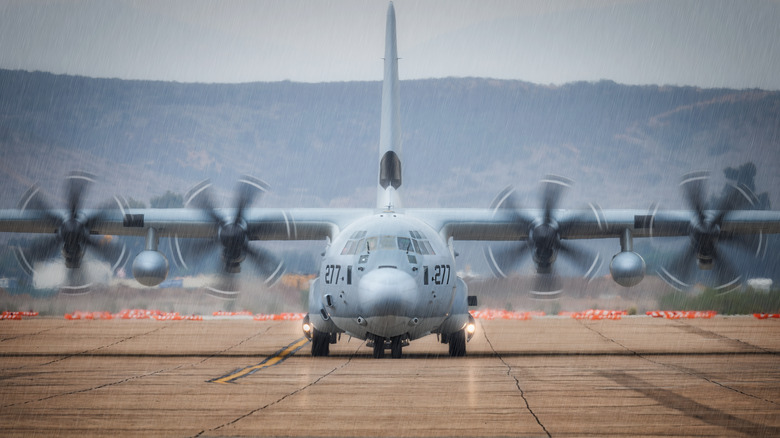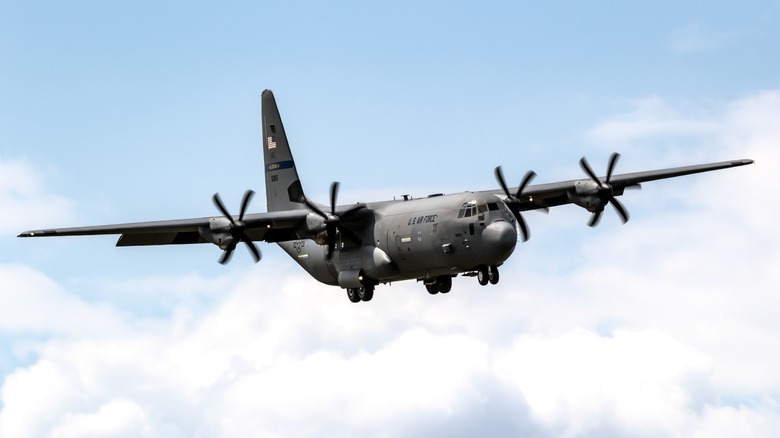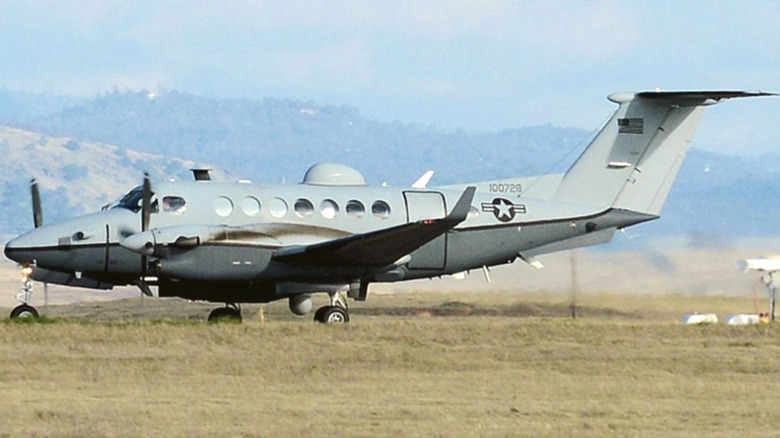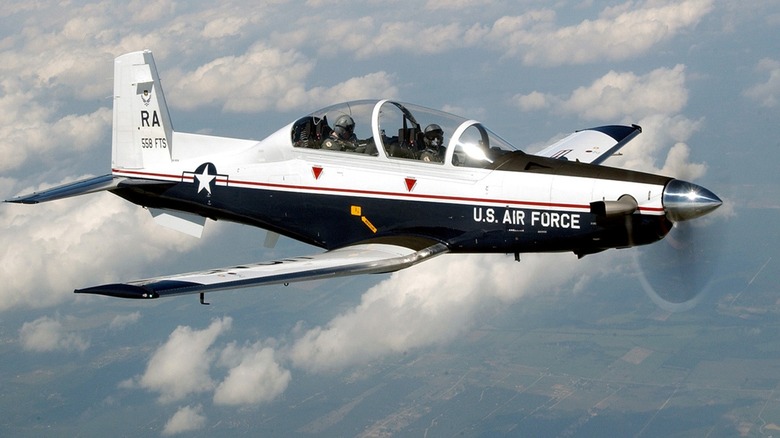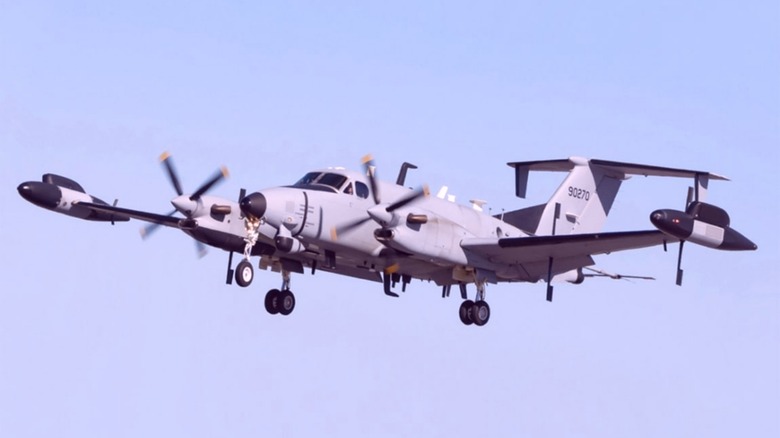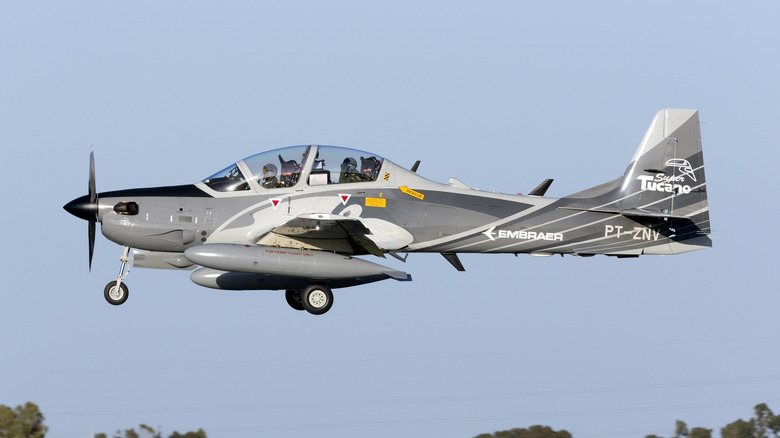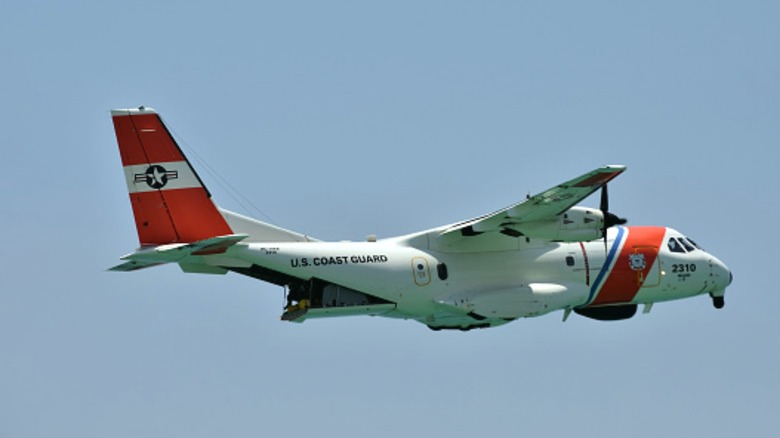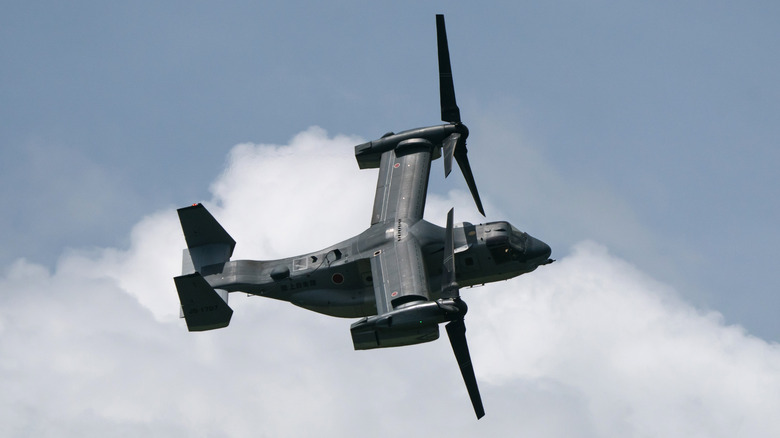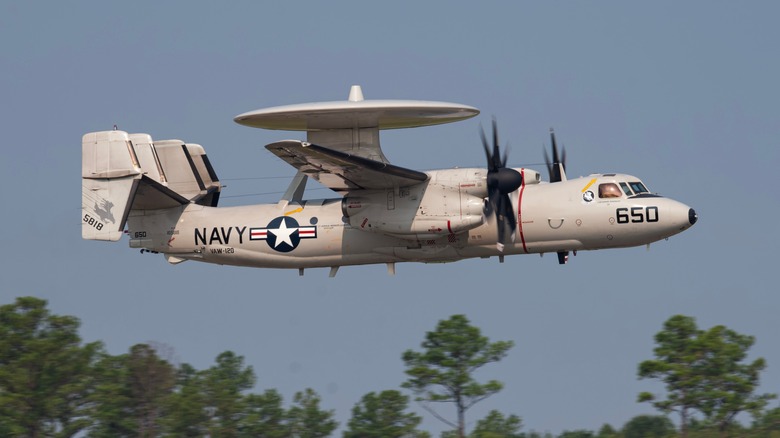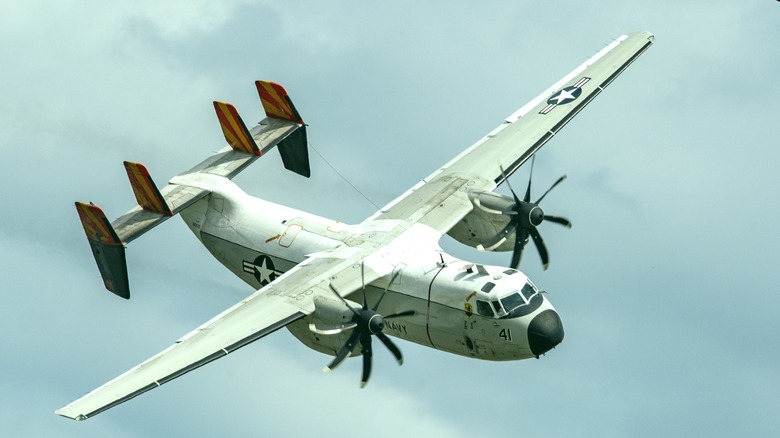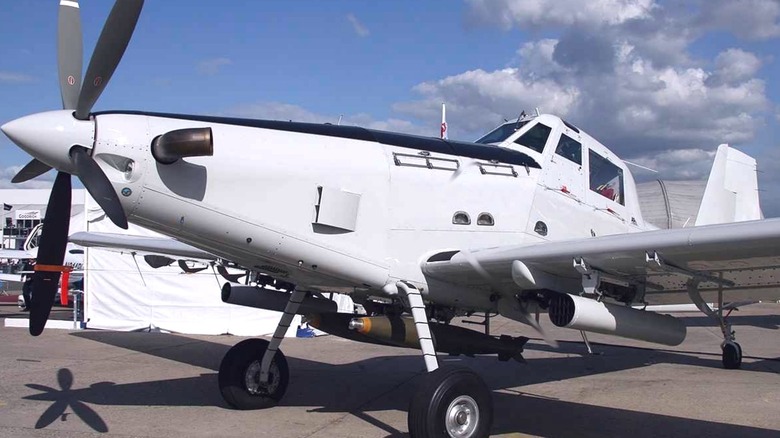10 Propeller Aircraft Still Used By The US Military
We live in an age of military jet engines and have since the tail end of World War II. For the most part, the majority of commercial and military aircraft are powered by jet engines, but some planes still use turboprops to get around the world's skies, and surprisingly, that includes the United States military. It's certainly not what most people would expect, given the prevalence of jets in use around the country in the 21st century, but as is often the case in the military, "if it ain't broke, don't fix it."
That applies to all kinds of aircraft operated by the U.S. military, especially those with propellers. Some propeller-driven aircraft are used primarily for transporting cargo and personnel, while others are used only for intelligence, surveillance, and reconnaissance purposes. Many unmanned aerial vehicles like the MQ-1 Predator, MQ-9 Reaper, RQ-11B Raven, and RQ-7 Shadow use propellers to get around, but when you're talking about larger manned aircraft, propellers are rarer.
Still, there are plenty of turboprop-driven aircraft around the world, and several militaries use them. In the U.S., all branches of the military, including the Army, operate aircraft with propellers. Given how heavily in use those systems are, it's unlikely they'll be replaced anytime soon by jets. Of course, that could happen in the future, but as of late 2024, the U.S. military operates these ten turboprop aircraft of various types outside of its UAV fleet.
C-130 Hercules
The C-130 Hercules is the workhorse of the United States Air Force, though it's used by other nations. The aircraft was first introduced in 1956, so it's been around for a long time. Like other military aircraft, the C-130 has been upgraded, updated, and modified into a variety of variants. The C-130 flown today is the Lockheed Martin C-130J Super Hercules, which featured updated engines, a new flight deck, and other improvements over older models.
Throughout its entire service record, the C-130 has remained a four-engine turboprop plane despite the readily available technology of different types of jet engines. The reason why the C-130 uses propellers instead of jets is due to the type of aircraft it is and the missions it undertakes. Turboprop engines require significantly less fuel than jets, and, as a transport aircraft, the C-130 doesn't need to be especially fast. Turboprops are also incredibly efficient for slower-moving aircraft at lower altitudes.
Even the legendary AC-130 gunship variant sports turboprops, so it's clear the Air Force isn't interested in modifying the aircraft to suit different engines. C-130s are used throughout the world, and they have several capabilities that make them ideal transport planes. A fully loaded C-130J can carry 90 fully equipped combat troops or 64 paratroopers. It can also carry six pallets of gear and equipment or 72 military litters if transporting casualties, so it's no wonder the Air Force continues to fly them despite the C-130 Hercules having been around for over 65 years.
MC-12W Liberty
The MC-12W Liberty is a U.S. Air Force variant of Hawker Beechcraft Super King Air 350, which has undergone significant modifications to suit the military's needs. The MC-12W Liberty was designed and implemented as an intelligence, surveillance, and reconnaissance (ISR) platform for use during Operations Enduring Freedom (OEF) and Iraqi Freedom (OIF) in Afghanistan and Iraq, respectively. The aircraft is powered by two Pratt & Whitney PT6A-60A turboprop engines, which enable it to fly up to 359 mph at a range of 2,726 miles.
The system consists of the aircraft, which is packed with sensors, and a ground exploitation cell. The Liberty program uses both line-of-sight and satellite communications during operation, and it's capable of collecting signals intelligence (SIGINT), Geospatial Intelligence (GEOINT), and more. The MC-12W is more than a sensor, as it's fully capable of collecting, processing, and disseminating intelligence to military commanders.
The first time an MC-12W collected intelligence in a combat zone came in June 2009, and by 2015, most of its missions were being taken over by the MQ-1 Predator and MQ-9 Reaper despite the fact that the Liberty Program was created to take the burden off these unmanned aerial systems (UAS). Because of this, the Air Force divested its fleet of MC-12W Liberties and transferred its 13 remaining aircraft to the 137th Air Wing, Oklahoma Air National Guard, after the MC-12W Liberty's mission in Afghanistan concluded.
[Featured image by U.S. Air Force via Wikimedia Commons | Cropped and scaled | Public Domain]
T-6A Texan II
If there's one turboprop aircraft that looks like it belongs squarely in the past, it's Beechcraft's T-6A Texan II. The single-engine aircraft is based on Raytheon's Beech/Pilatus PC-9 Mk. II, and was first introduced in 2000. While it has the appearance of a plane built in the 1960s, the T-6A is an advanced aircraft capable of aerobatics with a pressure-sealed cockpit used for pilot training. It was selected as the newest trainer for the U.S. Air Force and Navy, replacing those branches' Cessna T-37B Tweet and T-34C Turbomentor, respectively.
The T-6A is used solely for pilot training in the Joint Primary Pilot Training (JPPT) program, which instructs the fundamentals of aircraft flight to develop a pilot's base skillset. Because it's a trainer, the T-6A sports a stepped-tandem seating system, which enables the student to fly with an instructor, and the positions are interchangeable, though the front seat can fly the aircraft independently without anyone in the rear.
The T-6A sports a Pratt & Whitney Canada PT6A-68 turboprop engine, which enables the aircraft to reach speeds of 320 mph with a range of 1,035 miles. The two branches of the military that operate the T-6A collectively have 446 total aircraft. Instructor pilot training is conducted in numerous locations, including Moody Air Force Base (AFB) in Georgia, Columbus AFB in Mississippi, Vance AFB in Oklahoma, and Laughlin and Sheppard AFB in Texas.
[Featured image by U.S. Air Force via Wikimedia Commons | Cropped and scaled | Public Domain]
RC-12X Guardrail
The RC-12 Guardrail is based on Beechcraft's C-12 Huron and is used by the U.S. Army as a signals intelligence (SIGINT) platform. The Army began using the Guardrail in 1984 after heavily modifying the base aircraft to support various sensors and collection equipment. The Guardrail has been updated numerous times, and the latest model, the RC-12X+, arrived in 2016. You can see how unusual the aircraft is in the image due to its many antennas.
The RC-12X+ incorporates equipment for electronic intelligence (ELINT) collection and communications intelligence (COMINT) on top of the other INTs it supports, adding greater functionality over previous RC-12X systems. The Guardrail has been one of the leading collection platforms for SIGINT for over 40 years, which is largely due to its repeated success in the field. The RC-12X is outfitted with two Pratt & Whitney Canada PT6A-41 turboprop engines, each supporting four-bladed propellers.
If you're wondering why such an important intelligence collection system uses turboprops over jets, the reason is rather simple. The best means of collecting airborne ISR is through loitering, and jets would burn too much fuel and push the aircraft too fast to linger in an area without wasting a great deal of energy. While the Guardrail is effective, it's over 40 years old and is slated for retirement. The High Accuracy Detection and Exploitation System (HADES) will replace the Guardrail, beginning in 2027.
[Featured image by U.S. Air Force via Wikimedia Commons | Cropped and scaled | Public Domain]
A-29B Super Tucano
The Embraer EMB 314 Super Tucano is a Brazilian aircraft, so you may be wondering why it's coming up in an article about U.S. military turboprop planes, and there's a good reason for that. The system was designed to function as a light attack fighter capable of delivering different types of precision-guided weapon systems and other ordnance. Brazil, which exports the Super Tucano to other nations, developed the platform to support operations in low-threat environments in and out of South America.
While the Super Tucano appears antiquated by today's standards, it's a modern aircraft first introduced in 2003, and Brazil licenses its construction. The Sierra Nevada Corporation produces them in Jacksonville, Florida, in cooperation with the Brazilian and U.S. governments. Still, those aircraft are built for export to Nigeria, Afghanistan (formerly), and other nations, which doesn't explain why they're used in the U.S. military. In 2008, U.S. Special Operations Command (USSOCOM) began testing the A-29 as a viable platform for its missions, redesignating it the A-29B.
Initially, the U.S. Navy procured at least one aircraft, while the U.S. Air Force took in another for Air Force Special Operations Command's (AFSOC) Combat Aviation Advisor (CAA) mission. The aircraft is durable and flexible in its mission capabilities, it's relatively inexpensive to procure and operate, and it's reliable. The A-29B uses a Pratt & Whitney Canada PT6A-68C turboprop engine, enabling the aircraft to reach speeds of 320 mph, a maximum range of 1,784 miles with three fuel tanks, and a ceiling of 35,000 feet.
HC-144A Ocean Sentry
The U.S. Coast Guard is no stranger to operating aircraft, and while it's known for using the Sikorsky MH-60, the branch also employs various fixed-wing aircraft, including the HC-144A Ocean Sentry. The HC-144A is a twin-engine turboprop plane used primarily for search-and-rescue (SAR), drug and migrant interdiction, and maritime patrol missions throughout the Coast Guard's area of responsibility (AOR). The Coast Guard began using the HC-144A in 2009, and since then, 18 have entered the inventory.
The aircraft is based on Airbus' CASA/IPTN CN-235 tactical airlifter, and Airbus Defense and Space, Inc. is responsible for filling orders for the Coast Guard. The HC-144A has an eight-hour endurance, which makes it ideal for the types of missions they're utilized to support, and because the aircraft uses two General Electric CT7-9C3 turboprop engines, it typically doesn't waste fuel while performing relatively slow flights over large areas of open water.
The HC-144A can reach speeds of 283 mph, which isn't very fast, but it has a range of 2,301 miles, which is significant. The Coast Guard began upgrading its fleet of HC-144As to the newer model HC-144Bs in July 2016. The last of the 18 aircraft to undergo their refit and upgrade was completed in 2024. The HC-144Bs can now remain airborne for over ten hours, and they'll receive updated sensors. The Ocean Sentry Refresh project also replaced the cockpit control and display unit as well as several other onboard systems, ensuring the aircraft remains fully mission capable (FMC).
V-22 Osprey
The V-22 Osprey is a tiltrotor transport aircraft capable of vertical takeoff and landing (VTOL) and short takeoff and landing (STOL). It accomplishes this by literally tilting its rotors into a sky-facing position to take off, and once airborne, it returns the rotors to a front-facing position to operate like a twin turboprop fixed-wing plane. The aircraft is effectively a mashup of a helicopter and a plane, and like any military asset, the V-22 has its strengths and weaknesses.
The V-22 was designed after the failed hostage rescue during Operation Eagle Claw in 1980, as it was recognized that the U.S. required a long-range, high-speed VTOL aircraft. Still, it took a lot of engineering to work out the kinks, and sadly, there were several deadly accidents along the way. The V-22 entered the inventory in 2007, and it is operated by the U.S. Navy, Air Force, and Marine Corps, as well as the Japan Ground Self-Defense Force. The aircraft is fitted with two Rolls-Royce AE1107C turboprop engines.
Because of its tiltrotor functionality, the V-22 is a highly deployable aircraft capable of getting into and out of a variety of environments. They can be used to transport up to 32 personnel or 10,000 tons of cargo, and because they can land and take off like a helicopter, they can arrive and depart from locations without a runway. Still, just by tilting the rotors, the V-22 functions like a plane, which is capable of reaching speeds of 322 mph.
E-2D Hawkeye
The E-2 Hawkeye is a rather unusual-looking aircraft, thanks to its distinctive 24-foot diameter radar rotodome situated toward the back of the wings. The aircraft uses this as part of its active mission, which is to function as an airborne early warning and control system (AWACS) aircraft. The E-2 was the first plane built specifically for this purpose, and since its introduction in 1964, it has received some updates. The modern E-2 Hawkeye is designated E-2D Advanced Hawkeye (AHE), and it features advanced avionics, engines, a glass cockpit, and more.
Northrop Grumman holds the contract for the AHE, and the newer system is capable of operating in the same airspace as the F-35 Lightning II, F/A-18E/F Super Hornet, and other advanced aircraft. The AHE features two Rolls-Royce T56-A-427A Turboprop engines capable of moving the aircraft at over 345 mph to a ceiling of 37,000 feet. The AHE is operated by two pilots and three mission systems operators, though the co-pilot can function as a fourth operator if needed.
As an AWACS platform, the AHE maintains a 360-degree radar coverage, which enables mission flexibility, including functioning as a command and control (C2) aircraft, or it can be used for missile defense and border security. The U.S. Navy is responsible for operating the U.S. fleet of 79 AHE aircraft, though since the program started in the '60s, over 400 have been built in total. While they're operated by the Navy, the AHE provides situational awareness to warfighters across the board.
C-2 Greyhound
The C-2 Greyhound is a cargo aircraft utilized by the U.S. Navy, primarily for carrying supplies, passengers, and mail to and off of aircraft carriers as a carrier onboard delivery (COD) system. The aircraft first entered the inventory in 1966, and it's gone through some upgrades since then. The current model, the C-2A(R), incorporated advancements made for the C-2A, and several remain in service.
The C-2A(R) features two Allison T56-A-425 turboprop engines capable of moving the aircraft at speeds of 394 mph with a range of 1,151 miles. Greyhounds service all U.S. aircraft carriers, of which there are 11 operational as of late 2024, and they're based out of two locations. VRC-30 operates out of Naval Air North Island, California, with 12 C-2As, while two are based on the USS Kitty Hawk in Japan, though VRC-40 is headquartered at Naval Air Station (NAS) Norfolk, Virginia.
COD aircraft like the C-2 are incredibly important to normal carrier operations because without them, transporting to and from a carrier would be more difficult, given the long distances they operate away from port. Unfortunately, for fans of the C-2 Greyhound, it's being retired by the Navy. Initially, the plan was to replace them with the CVM-22B Osprey by 2027, but the timeline was shifted such that replacements began arriving in 2020 and 2021. The C-2 will stop operating sometime in 2026 once all of the aircraft are retired by the Navy.
OA-1K Sky Warden
The OA-1K Sky Warden is a light attack reconnaissance aircraft used by USSOCOM's Armed Overwatch program. The aircraft was developed from the Air Tractor AT-802. SOCOM took possession of its first OA-1K Sky Warden in late 2024, which it planned to utilize for light attack, armed overwatch, scouting, close air support, ISR, and counterinsurgency operations.
The U.S. military contracted L3Harris for 75 aircraft at a cost of $3 billion. The OA-1K is an intelligence collection platform with a six-hour loiter over a target area. They feature 10 hardpoints, but it's unclear what types of weapon systems will be installed, and USSOCOM isn't in the habit of revealing many details about its equipment. In terms of power, the OA-1K features a single Pratt & Whitney PT6A-67F turboprop engine capable of taking the aircraft out to a radius of nearly 1,500 miles at a speed of 245 mph.
If you're wondering why SOCOM wants a relatively slow-moving platform like the OA-1K, it's to fill a niche that's incapable of being serviced by more advanced aircraft. The OA-1K can loiter for hours, delivering ISR support while simultaneously providing armed overwatch. The OA-1K can fill this need for USSOCOM operations, specifically in austere environments that aren't as accessible to other aircraft. Despite the prevalence of jet technology, the OA-1K and all the aforementioned aircraft prove the continued viability of turboprop planes in the 21st century.
[Featured image by PvK via Wikimedia Commons | Cropped and scaled | CC BY-SA 3.0]
